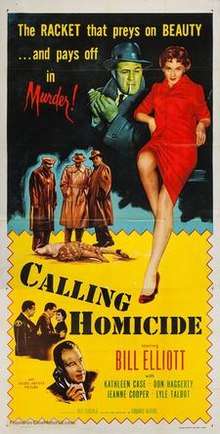Calling Homicide
Calling Homicide is a 1956 American police drama film directed by Edward Bernds, which stars Bill Elliott, Don Haggerty, and Kathleen Case. The picture was the third of five films in the "Lt. Andy Doyle" series, all starring Elliott.[2]
| Calling Homicide | |
|---|---|
 Poster for the film | |
| Directed by | Edward Bernds |
| Produced by | Ben Schwalb |
| Written by | Edward Bernds |
| Starring | Bill Elliott Don Haggerty Kathleen Case |
| Music by | Marlin Skiles |
| Cinematography | Harry Neumann |
| Edited by | William Austin |
Production company | |
Release date |
|
Running time | 61 minutes |
| Country | United States |
| Language | English |
Plot
When one of their own is murdered by a car bomb Lt. Andy Doyle is given the case to investigate. In the young cop's notes is the name of a woman, Francine Norman, who is murdered shortly thereafter, strangled and mutilated. Doyle figures out there is a connection between the two deaths. Norman was a former actress who owned a modelling agency, which is now being run by Darlene Adams.
While investigating, Doyle comes to understand that there is no dearth of suspects, as Norman was universally hated. Doyle uncovers that the agency was being used as a front for a blackmailing racket, which evidence points to being run by Norman's love interest, Jim Haddix, the owner of a local construction company. However, all the evidence of the blackmail ring is destroyed when the modeling school is destroyed by fire, with the janitor as the main suspect.
Cast list
- Bill Elliott as Lt. Andy Doyle
- Don Haggerty as Sgt. Mike Duncan
- Kathleen Case as Donna Graham
- Myron Healey as Jim Haddix
- Jeanne Cooper as Darlene Adams
- Thomas B. Henry as Alan Gilmore
- Lyle Talbot as Tony Fuller
- Almira Sessions as Ida Dunstetter
- Herb Vigran as Ray Engel
- James Best as Arnie Arnholf
- John Dennis as Benny Bendowski
- Robert Bice as Phipps
- John Close as Deputy Warren
- Mel Wells as Valensi
- Dee Carroll as Rita
- Stanley Adams as Peter Van Elda
- Mary Treen as Flo Burton
- Jack Mulhall as Pierson
- William Meigs as Ted Allen
- Harry Strang as Deputy Wall
Production
The working title of this film was House on Lookout Mountain.[1] Production began in the first week of April, 1956,[3][4] and was completed before the end of the month.[5][6] In July, it was announced that the release date would be September 30, 1956.[7] The National Legion of Decency gave the film an "A" rating, "Section II" - indicating it was orally unobjectionable for adults.[8] In December it was announced that Calling Homicide would be part of a two-film deal, along with Friendly Persuasion, booking first-run films directly into "second-run" theaters. It was the first such deal in the nation.[9]
Reception
Motion Picture Daily gave the film a good review, enjoying its action and pace. They complimented the complexity of the plot, as well as the screenplay and direction of Bernds.[10]
References
- "Calling Homicide: Detail View". American Film Institute. Archived from the original on September 4, 2017. Retrieved September 4, 2017.
- "Dial Red O". American Film Institute. Archived from the original on February 18, 2018. Retrieved February 18, 2018.
- "This Week in Production". Motion Picture Herald. April 14, 1956. p. 25. Retrieved February 18, 2018.

- "Nine Pictures Start Production on Coast". Motion Picture Daily. April 13, 1956. p. 3. Retrieved February 18, 2018.

- "This Week in Production". Motion Picture Herald. April 28, 1956. p. 30. Retrieved February 18, 2018.

- "Production Falls Off To 34; Only 3 Start". Motion Picture Daily. April 26, 1956. p. 3. Retrieved February 18, 2018.

- "Release Schedule for Features:Allied Artists Features". Harrison's Reports. July 7, 1956. p. 2. Retrieved February 17, 2018.

- "Legion Approves 9 of 16 New Films". Motion Picture Herald. December 15, 1956. p. 17. Retrieved February 18, 2018.

- "Book 'Persuasion' in 8 Detroit Second-Runs". Motion Picture Daily. December 3, 1956. p. 2. Retrieved February 18, 2018.

- "Calling Homicide". Motion Picture Daily. October 15, 1956. p. 5. Retrieved February 18, 2018.
